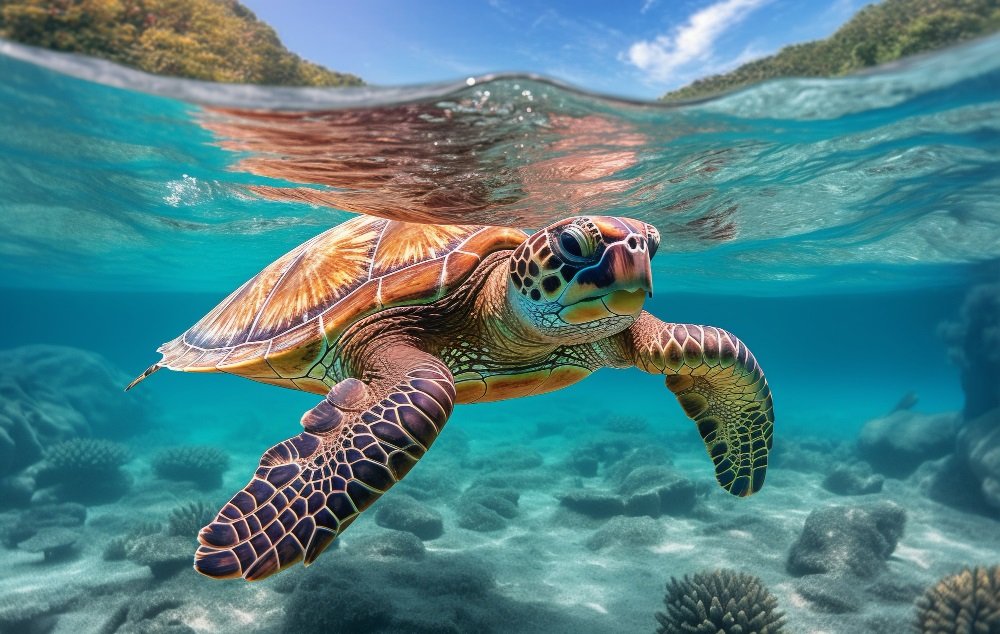Oceans cover over 70% of the Earth’s surface, and they are home to a vast array of marine life. Among the many fascinating creatures that inhabit our oceans, turtles are some of the most iconic and intriguing. With over 300 species of turtles, it’s no wonder that many people are curious about which ones call the ocean their home. Understanding which turtles live in the ocean is not only interesting from a biological perspective, but it’s also crucial for conservation efforts and protecting these incredible animals and their habitats.
Overview of Ocean-Dwelling Turtles
Turtles have been on our planet for over 220 million years, and during that time, they have evolved to thrive in various aquatic environments. While many species of turtles live in freshwater habitats, such as rivers and lakes, a significant number of species are adapted to life in the ocean. In this article, we will delve into the world of ocean-dwelling turtles, exploring the different species that call the ocean home, their habitats, and their unique characteristics.
What to Expect
In the following sections, we will take a closer look at the seven species of sea turtles, which are the most well-known ocean-dwelling turtles. We will also explore other species of turtles that spend part of their lives in the ocean, such as the terrestrial turtles that migrate to the ocean to breed or feed. Additionally, we will discuss the threats that ocean-dwelling turtles face, such as habitat destruction, pollution, and climate change, and what we can do to help protect these incredible creatures.
What Turtles Live in the Ocean?
Oceans cover over 70% of the Earth’s surface, and they are home to a diverse range of marine life. Among the many creatures that inhabit the ocean, turtles are one of the most fascinating and iconic species. There are seven species of sea turtles, each with unique characteristics and adaptations that enable them to thrive in the ocean environment. In this article, we will explore the different species of turtles that live in the ocean, their habitats, behaviors, and the challenges they face in the modern world.
Species of Sea Turtles
There are seven species of sea turtles, which are divided into two families: Cheloniidae (true sea turtles) and Dermochelyidae (leatherback sea turtles). Here is a list of the seven species of sea turtles:
- Leatherback Sea Turtle (Dermochelys coriacea)
- Green Sea Turtle (Chelonia mydas)
- Kemp’s Ridley Sea Turtle (Lepidochelys kempii)
- Olive Ridley Sea Turtle (Lepidochelys olivacea)
- Hawksbill Sea Turtle (Eretmochelys imbricata)
- Flatback Sea Turtle (Natator depressus)
Habitats of Sea Turtles
Sea turtles can be found in all the world’s oceans, from the warm waters of the tropics to the cold waters of the Arctic and Antarctic. They inhabit a range of habitats, including coral reefs, estuaries, mangrove swamps, and open ocean. Each species has its preferred habitat, and they can be found in different parts of the ocean at different times of the year.
Coral Reefs: Coral reefs are one of the most important habitats for sea turtles. Many species of sea turtles feed on the seaweed and algae that grow on coral reefs, and they also use the reefs as a place to rest and hide from predators.
Estuaries: Estuaries are areas where freshwater rivers meet the ocean, and they are an important habitat for many species of sea turtles. Estuaries provide a safe place for sea turtles to feed, nest, and escape from predators.
Mangrove Swamps: Mangrove swamps are coastal ecosystems found in tropical and subtropical regions. They are an important habitat for many species of sea turtles, providing a place to feed, nest, and hide from predators.
Behaviors of Sea Turtles
Sea turtles have a range of behaviors that help them survive in the ocean environment. Here are some of the most interesting behaviors of sea turtles: (See Also: When Do Sea Turtles Hatch In Outer Banks)
Migration: Sea turtles are known for their incredible migrations. They can travel thousands of miles each year to reach their breeding grounds, feeding grounds, and nesting sites.
Nesting: Female sea turtles come ashore to nest, digging holes in the sand to lay their eggs. The eggs incubate in the sand for several weeks before hatching, and the hatchlings make their way to the ocean.
Feeding: Sea turtles are omnivores, and they feed on a range of foods including seaweed, algae, crustaceans, and fish. Each species has its preferred food source, and they have adapted to feed in different ways.
Hibernation: Some species of sea turtles hibernate during the winter months, slowing down their metabolism to conserve energy. This behavior helps them survive in areas where food is scarce during the winter.
Challenges Facing Sea Turtles
Sea turtles face a range of challenges in the modern world, including:
Habitat Destruction: The destruction of coral reefs, estuaries, and mangrove swamps has reduced the available habitat for sea turtles. This has made it harder for them to find food, shelter, and breeding grounds.
Pollution: Plastic pollution, oil spills, and other forms of pollution have harmed sea turtles and their habitats. Sea turtles can ingest plastic, which can cause blockages and nutrient deficiencies.
Overfishing: Sea turtles are often caught accidentally in fishing gear, which can cause injury or death. This has reduced the populations of many species of sea turtles.
Climate Change: Climate change is affecting the ocean environment, causing changes in sea temperature, sea level, and ocean chemistry. This has made it harder for sea turtles to adapt and survive. (See Also: How Long Do Softshell Turtles Live)
Conservation Efforts
There are many conservation efforts underway to protect sea turtles and their habitats. Some of the most important efforts include:
Protected Areas: Many countries have established protected areas, such as marine reserves and national parks, to protect sea turtle habitats.
Research and Monitoring: Scientists are conducting research and monitoring programs to better understand sea turtle behavior, habitat, and population dynamics.
Education and Awareness: Educational programs are helping to raise awareness about the importance of sea turtle conservation and the threats they face.
Reduction of Bycatch: Fisheries are working to reduce bycatch, the catching of non-target species, including sea turtles.
Conclusion
In conclusion, sea turtles are fascinating creatures that play a vital role in the ocean ecosystem. They have adapted to live in the ocean environment, and they have unique characteristics and behaviors that enable them to thrive. However, they face many challenges in the modern world, including habitat destruction, pollution, overfishing, and climate change. It is essential that we take action to protect sea turtles and their habitats, and conservation efforts are underway to address these challenges.
Recap: In this article, we have explored the different species of sea turtles, their habitats, behaviors, and the challenges they face. We have also discussed the conservation efforts underway to protect sea turtles and their habitats.
By understanding more about sea turtles and the challenges they face, we can work together to protect these incredible creatures and the ocean environment they inhabit. (See Also: Can 2 Turtles Live In The Same Tank)



